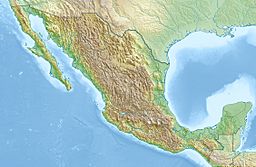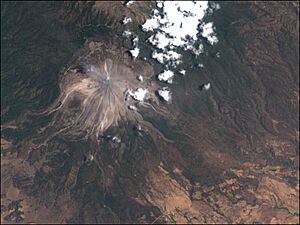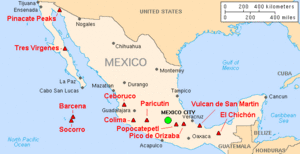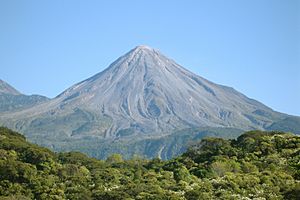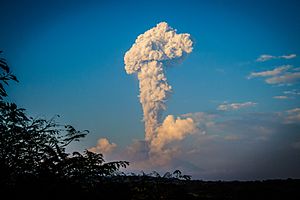Volcán de Colima facts for kids
Quick facts for kids Volcán de Colima |
|
|---|---|
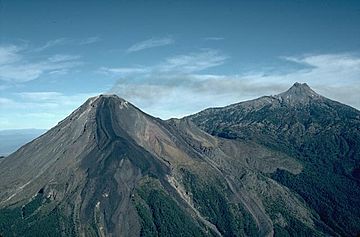
Volcán de Colima is on the left with Nevado de Colima on the right.
|
|
| Highest point | |
| Elevation | 3820+ m (12,533+ ft) |
| Prominence | 600 m (2,000 ft) |
| Listing |
|
| Geography | |
| Location | Jalisco / Colima, Mexico |
| Parent range | Trans-Mexican Volcanic Belt |
| Geology | |
| Age of rock | 5 million years |
| Mountain type | Stratovolcano |
| Volcanic arc/belt | Trans-Mexican Volcanic Belt |
| Last eruption | 2013 to 2018 (ongoing) |
The Volcán de Colima, also known as Volcán de Fuego (which means "Fire Volcano"), is a very active volcano in Mexico. It stands about 3,820 meters (12,533 feet) tall. It is part of a group of volcanoes called the Colima Volcanic Complex.
This group includes Volcán de Colima, Nevado de Colima, and the older, inactive El Cántaro. Volcán de Colima is the youngest and most active of the three. Since 1576, it has erupted over 40 times! One of its biggest eruptions happened in January 1913.
Nevado de Colima is about 5 kilometers (3 miles) north of Volcán de Colima. It is taller, reaching 4,271 meters (14,012 feet).
Even though it's called "Colima," most of the volcano is actually in the state of Jalisco. Only a small part is in the state of Colima. It is about 485 kilometers (300 miles) west of Mexico City and 125 kilometers (78 miles) south of Guadalajara, Jalisco.
Since the late 1800s, a smaller group of domes called El Volcancito has grown on the side of the main volcano.
How the Colima Volcano Formed
In the past, a very long time ago, a huge landslide happened at the mountain. About 25 cubic kilometers (6 cubic miles) of rock and dirt slid down. This material traveled about 120 kilometers (75 miles) all the way to the Pacific Ocean! The landslide covered an area of about 2,200 square kilometers (850 square miles).
The volcano we see today sits inside a large bowl-shaped area called a caldera. This caldera likely formed from a mix of landslides and big eruptions. The lava from the volcano is a type called andesite. It contains a lot of silica, which makes it thick.
About 300,000 people live within 40 kilometers (25 miles) of the volcano. This makes it one of the most dangerous volcanoes in Mexico. Because it has a history of large eruptions and many people live nearby, it was named a Decade Volcano. This means scientists study it closely to understand it better.
Recent Volcano Activity
In recent years, people living near the volcano have often had to move away temporarily. This happens when the volcano shows signs of threatening activity.
Eruptions happened in 1991, 1998–1999, and from 2001 until recently. The volcano often produces thick lava that forms a lava dome at its top. Sometimes, there are bigger explosions. These explosions create pyroclastic flows, which are fast-moving clouds of hot gas and rock. They also cover nearby areas with ash and small rocks called tephra.
One of the biggest eruptions in recent years happened on May 24, 2005. An ash cloud rose more than 3 kilometers (1.9 miles) above the volcano. Satellites showed that this cloud spread over 110 kilometers (68 miles) west of the volcano. Hot pyroclastic flows traveled 4–5 kilometers (2.5–3.1 miles) from the top. Hot rocks called lava bombs landed 3–4 kilometers (1.9–2.5 miles) away. Because of this, authorities created a safety zone. No one was allowed within 6.5 kilometers (4 miles) of the summit.
On November 21, 2014, the volcano erupted again. An ash column shot 5 kilometers (3.1 miles) into the air. This ash covered towns as far as 25 kilometers (15.5 miles) away. Luckily, no one was hurt, and no evacuations were needed. More eruptions happened on January 10, 21, and 25, 2015. Ash from the January 21 eruption fell in towns more than 15 miles (24 kilometers) away.
On July 10, 2015, another eruption occurred. Then, on September 25, 2016, a plume of ash and smoke went 10,000 feet (3,000 meters) into the sky. In December 2016, ash plumes happened almost every day. On December 18, 2016, there were three eruptions. The largest ash columns reached 2 kilometers (1.2 miles) high.
Colima volcano had another strong explosion on January 18, 2017. This eruption sent volcanic ash up to 4 kilometers (13,123 feet) above the crater.
Watching the Volcano
The Colima Volcano Observatory at the University of Colima in Mexico watches the volcano very closely. A team of scientists studies every event that happens at the volcano. They analyze the data and share information about its activity.
In 2018, a special webcam was set up near the volcano. This allows people to see the volcano's activity live, in real-time.
See also
 In Spanish: Volcán de Colima para niños
In Spanish: Volcán de Colima para niños


